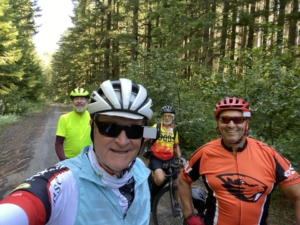Safety: Reducing Skin Cancer Risk
 In September, I wrote about sun protection. This topic hits close to home with me, and here’s why. I have spent a lifetime outside in the sun biking or kitesurfing, and had a recent scare when a dark spot appeared on my cheekbone. I made an appointment to see my doctor and then the horrible thoughts started creeping into my head. Could it be SKIN CANCER? Lucky for me, it was not melanoma but a benign solar lentigo. The thought though of something more serious made me think about paying attention to my skin. ✎
In September, I wrote about sun protection. This topic hits close to home with me, and here’s why. I have spent a lifetime outside in the sun biking or kitesurfing, and had a recent scare when a dark spot appeared on my cheekbone. I made an appointment to see my doctor and then the horrible thoughts started creeping into my head. Could it be SKIN CANCER? Lucky for me, it was not melanoma but a benign solar lentigo. The thought though of something more serious made me think about paying attention to my skin. ✎
Common risk factors for skin cancer to be aware of include being over 50, having fair skin or hair, light-colored eyes, skin that burns easily, lots of freckles or moles, and family history of skin cancer.
Early detection is key, so self-exams are important. Be sure to examine all your skin, even places that don’t get much sunlight (feet, groin, etc.) and hard to see places (top of head). What to look for in spots on your skin:
- Asymmetry
- Border changes
- Color
- Diameter increasing
- Evolving shapes
If you are concerned about a spot, be sure to inform your physician to have it evaluated. There are five things you can do to reduce the risk of skin cancer. Of course, none of this should mean you don’t go out and ride, it’s just a case of managing the risk.
- Don’t ride when the sun is strongest, and seek shade. During Oregon summertime, the sun’s ultraviolet rays are strongest between 10 AM and 4 PM, so, when possible, think about going for a ride before 10 AM or after 4 PM, when the sun isn’t as strong. When you are stopping for breaks, remember to go to a shaded area to avoid too much sun.
- Cover up. You can’t ride in the shade all the time, so use clothing to help cover up also. The clothing should have a tight weave; hold it up to the light to see if you can see through it. There are increasing numbers of products available that offer sun protection or UPF (Ultraviolet Protection Factor), from arm sleeves to jerseys, so it’s worth considering investing in these. Sunglasses are important, and consider helmets with a visor. If your helmet doesn’t have a visor, pop a lightweight cap underneath for some additional shade.
- Use sunscreen, use it properly, and reapply it regularly – even once-a-day sunscreen. Most people just slather on sunscreen once and think they are done. Applying it properly and reapplying it regularly is crucial for it to be effective. Many people think sunscreen is bulletproof, but it should only be used as the last line of defense on the places you can’t cover with clothes. Sunscreens with SPF 15 block 93% of UVB radiation and SPF 30 block 97%. Increasing SPF provides minimal difference in protection and can lure people into thinking they can stay out in the sun longer. SPF 15 or 30 should provide enough protection, when used properly.
- Know your skin type. People with some skin types are particularly susceptible, need to be more careful, and already know to be diligent about checking. On the other hand, people at a lower risk with darker skin should not disregard protection, because all skin types are vulnerable.
- Look out for the warning signs. Keep an eye on any moles or unusual and persistent raised patches of skin. If you notice any changes, or you’re concerned at all, visit your doctor.
My story turned out well, but I have learned to pay attention to my skin and protect it, and urge you to do so as well.
Mark Barnes, Member at Large
